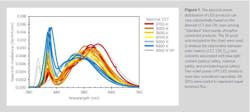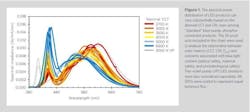To further clarify the agency's position on the safety of LED-based lighting, the US Department of Energy has again addressed the blue spectral content in solid-state lighting, and separately the agency's MSSLC revealed results of a roadway lighting survey.
The US Department of Energy (DOE) has published a report entitled "True Colors" that once gain affirms the agency's position on the potential hazard of LED-based lighting attributable to blue energy in the spectral power distribution of solid-state lighting (SSL) products. The study focuses on the relationship between CCT and CRI, and optical safety and photobiological stimulation. Meanwhile, in the outdoor lighting area, the DOE has released the results of a roadway lighting study conducted by the agency's Municipal Solid State Lighting Consortium (MSSLC).
The DOE had previously released a fact sheet on LED lighting and the blue light hazard. The agency stated at the time that LEDs posed no more danger than legacy sources with similar CCT ratings. Still, some researchers and alarmists continue to speculate that the blue-peak typically seen in the spectral power distribution (SPD) of an LED poses risks to human wellbeing.
In the new report, the DOE fully documents the SPD of LED sources with varying CCT ratings (see figure). The document affirms that there is typically a blue peak in the 450-nm range that is due to the blue emitters used in phosphor-converted white LEDs and that peak is consistent regardless of CCT. Still, the report states that legacy sources with similar CCTs also contain similar percentages of energy in the blue range and pose an equal optical-safety risk even if there is not a blue energy peak in the SPD.
The report also addresses the potential of blue-pump-based LEDs to damage materials such as works of art. The DOE notes that museum curators have already debunked any risk of damage from LED-based lighting. Moreover, the report states that LEDs are less likely to cause damage to artwork than legacy sources due to less energy emitted outside the human sensitivity range – specifically less energy in the ultraviolet (UV) and infrared (IR) regions.
Finally, the DOE addressed the potential effect of LEDs on the photobiological concerns and the human circadian rhythm. The report first notes that how the human physiological system works is still being debated, as we covered recently. But again the percentage of blue energy in SSL products is similar to that in legacy sources with similar CCTs. You can review the full report on the DOE website.
MSSLC and roadway lighting
In a separate announcement, the DOE has also released the results of a roadway lighting survey conducted by the MSSLC. The survey was meant to shed lighting on the penetration rate of LEDs and the potential for additional energy savings through SSL retrofits.
The MSSL surveyed 240 organizations including municipalities, counties, state departments of transportation, investor-owned utilities, and municipally-owned utilities. The results show moderate LED penetration and significant opportunities for further savings.
The results indicate that the majority of respondents have some LED-based lighting in their street-lighting inventory, but only 8% considered it the most prominent technology installed. Meanwhile, 82% still say high-pressure sodium (HPS) is most prominent. Moreover, 36% still use mercury vapor lights that trail both HPS and LED sources in efficacy.
Indeed, the average age of installed roadway lighting in the survey is 15.3 years with the departments of transportations reporting an even higher 17.6 years. Clearly there is ample opportunity for SSL deployment and in fact we are still in the early stage of the transition to LED sources. Read the full report on the DOE website.
The MSSLC is an organization founded to help municipalities and utilities to simplify the transition to LEDs. The organization recently published its v2.0 of a luminaire model specification that can be used to simplify the SSL procurement process.







